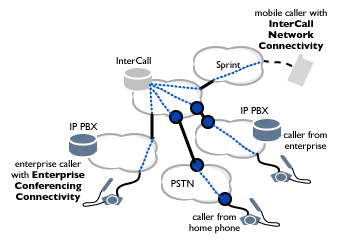The challenge for any user of audio communications in recent years is how ‘toll quality’ expectation has been severely eroded with wireless compression and more recently through the success of IP PBX products and IP services for voice communications.
With wireless services, the basic radio protocols slice the bandwidth used by the transmitted signal so that many, many users can share a limited licensed resource. Fortunately, the nasty analog surges and static overwhelming the spoken word has become a thing of the past due to the introduction and rapid deployment of digital wireless networks starting around 1995 in the USA.
InterCall, formed in 1991 and acquired by West Corporation in 2003, has been a conferencing specialist for many years and has migrated its infrastructure from an all-digital architecture to all IP for both lower operating cost reasons and eventually, higher qualityreasons.
 Today, these digital radio signals are packetized and routed over an IP backhaul network to the terminating device or gateway. For customers of both Sprint Wireless and InterCall, the wireless caller’s session is delivered over IP directly to the appropriate InterCall server for binding with the other participants in the conference call.
Today, these digital radio signals are packetized and routed over an IP backhaul network to the terminating device or gateway. For customers of both Sprint Wireless and InterCall, the wireless caller’s session is delivered over IP directly to the appropriate InterCall server for binding with the other participants in the conference call.
This call handling, called InterCall Network Connectivity is shown in the upper right hand part of the figure. The service assures a higher quality experience for both the mobile and the InterCall user since there is no IP-digital and digital-IP conversion (blue dots) in the call. It is all-IP from wireless base-station to conference bridge.
This capability has been extended through an agreement with Sprint where the carrier has all the InterCall telephone numbers programmed in its network. The enterprise-specific service, called Enterprise Conferencing Connectivity, positions a managed router on the enterprise premise directs all enterprise conference calls originating from the enterprise IP PBX (shown at lower left) over the MPLS circuit directly into the InterCall backbone for an all-IP transmission path. Considering the typically superior local network, sampling audio capture electronics and software on the enterprise endpoint, this is the highest quality audio conferencing experience. Of course, only the largest consumers of audio conferencing minutes can benefit from the economics of an ECC deployment at this time. No doubt this forms a strong ‘sticky’ advantage for InterCall.
Generally, the more times an audio signal is packetized and depacketized, the lower the quality of the signal. As shown in the figure, traffic from participants on a non-InterCall ECC network traverse at least two gateways which are represented as blue dots.
The lowest grade experience is the caller from home, who might subscribe to a cableco VoIP service, in which case their analog phone feeds an ATA (analog terminal adapter), the service provider forwards the packets to a PSTN gateway which then traverses the digital network (or over another IP interval) and then over the gateway on the edge of the InterCall network to terminate the session on the InterCall server.
We can say that as the number of hops grows from zero to two, to three to five the user experience can be greatly impacted. Service innovations like the INC or the ECC reduce the incidence of these nasty hops. They are consistent with the ultimate goal of an all-IP communications environment, proving our earlier contention that higher QUALITY is the ultimate benefit of the industry’s long transition from digital to IP.









